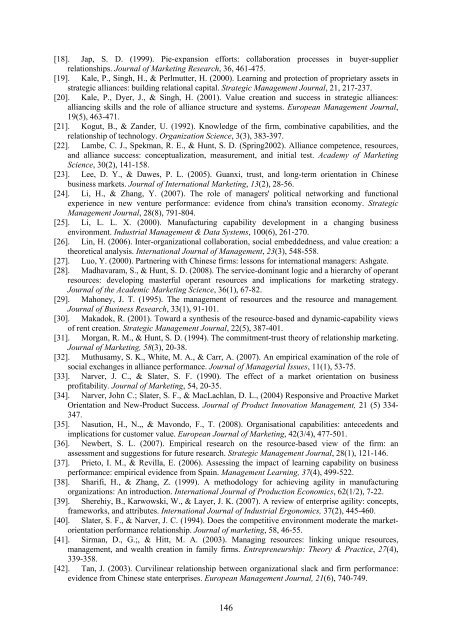Workshop proceeding - final.pdf - Faculty of Information and ...
Workshop proceeding - final.pdf - Faculty of Information and ...
Workshop proceeding - final.pdf - Faculty of Information and ...
You also want an ePaper? Increase the reach of your titles
YUMPU automatically turns print PDFs into web optimized ePapers that Google loves.
[18]. Jap, S. D. (1999). Pie-expansion efforts: collaboration processes in buyer-supplier<br />
relationships. Journal <strong>of</strong> Marketing Research, 36, 461-475.<br />
[19]. Kale, P., Singh, H., & Perlmutter, H. (2000). Learning <strong>and</strong> protection <strong>of</strong> proprietary assets in<br />
strategic alliances: building relational capital. Strategic Management Journal, 21, 217-237.<br />
[20]. Kale, P., Dyer, J., & Singh, H. (2001). Value creation <strong>and</strong> success in strategic alliances:<br />
alliancing skills <strong>and</strong> the role <strong>of</strong> alliance structure <strong>and</strong> systems. European Management Journal,<br />
19(5), 463-471.<br />
[21]. Kogut, B., & Z<strong>and</strong>er, U. (1992). Knowledge <strong>of</strong> the firm, combinative capabilities, <strong>and</strong> the<br />
relationship <strong>of</strong> technology. Organization Science, 3(3), 383-397.<br />
[22]. Lambe, C. J., Spekman, R. E., & Hunt, S. D. (Spring2002). Alliance competence, resources,<br />
<strong>and</strong> alliance success: conceptualization, measurement, <strong>and</strong> initial test. Academy <strong>of</strong> Marketing<br />
Science, 30(2), 141-158.<br />
[23]. Lee, D. Y., & Dawes, P. L. (2005). Guanxi, trust, <strong>and</strong> long-term orientation in Chinese<br />
business markets. Journal <strong>of</strong> International Marketing, 13(2), 28-56.<br />
[24]. Li, H., & Zhang, Y. (2007). The role <strong>of</strong> managers' political networking <strong>and</strong> functional<br />
experience in new venture performance: evidence from china's transition economy. Strategic<br />
Management Journal, 28(8), 791-804.<br />
[25]. Li, L. L. X. (2000). Manufacturing capability development in a changing business<br />
environment. Industrial Management & Data Systems, 100(6), 261-270.<br />
[26]. Lin, H. (2006). Inter-organizational collaboration, social embeddedness, <strong>and</strong> value creation: a<br />
theoretical analysis. International Journal <strong>of</strong> Management, 23(3), 548-558.<br />
[27]. Luo, Y. (2000). Partnering with Chinese firms: lessons for international managers: Ashgate.<br />
[28]. Madhavaram, S., & Hunt, S. D. (2008). The service-dominant logic <strong>and</strong> a hierarchy <strong>of</strong> operant<br />
resources: developing masterful operant resources <strong>and</strong> implications for marketing strategy.<br />
Journal <strong>of</strong> the Academic Marketing Science, 36(1), 67-82.<br />
[29]. Mahoney, J. T. (1995). The management <strong>of</strong> resources <strong>and</strong> the resource <strong>and</strong> management.<br />
Journal <strong>of</strong> Business Research, 33(1), 91-101.<br />
[30]. Makadok, R. (2001). Toward a synthesis <strong>of</strong> the resource-based <strong>and</strong> dynamic-capability views<br />
<strong>of</strong> rent creation. Strategic Management Journal, 22(5), 387-401.<br />
[31]. Morgan, R. M., & Hunt, S. D. (1994). The commitment-trust theory <strong>of</strong> relationship marketing.<br />
Journal <strong>of</strong> Marketing, 58(3), 20-38.<br />
[32]. Muthusamy, S. K., White, M. A., & Carr, A. (2007). An empirical examination <strong>of</strong> the role <strong>of</strong><br />
social exchanges in alliance performance. Journal <strong>of</strong> Managerial Issues, 11(1), 53-75.<br />
[33]. Narver, J. C., & Slater, S. F. (1990). The effect <strong>of</strong> a market orientation on business<br />
pr<strong>of</strong>itability. Journal <strong>of</strong> Marketing, 54, 20-35.<br />
[34]. Narver, John C.; Slater, S. F., & MacLachlan, D. L., (2004) Responsive <strong>and</strong> Proactive Market<br />
Orientation <strong>and</strong> New-Product Success. Journal <strong>of</strong> Product Innovation Management, 21 (5) 334-<br />
347.<br />
[35]. Nasution, H., N.,, & Mavondo, F., T. (2008). Organisational capabilities: antecedents <strong>and</strong><br />
implications for customer value. European Journal <strong>of</strong> Marketing, 42(3/4), 477-501.<br />
[36]. Newbert, S. L. (2007). Empirical research on the resource-based view <strong>of</strong> the firm: an<br />
assessment <strong>and</strong> suggestions for future research. Strategic Management Journal, 28(1), 121-146.<br />
[37]. Prieto, I. M., & Revilla, E. (2006). Assessing the impact <strong>of</strong> learning capability on business<br />
performance: empirical evidence from Spain. Management Learning, 37(4), 499-522.<br />
[38]. Sharifi, H., & Zhang, Z. (1999). A methodology for achieving agility in manufacturing<br />
organizations: An introduction. International Journal <strong>of</strong> Production Economics, 62(1/2), 7-22.<br />
[39]. Sherehiy, B., Karwowski, W., & Layer, J. K. (2007). A review <strong>of</strong> enterprise agility: concepts,<br />
frameworks, <strong>and</strong> attributes. International Journal <strong>of</strong> Industrial Ergonomics, 37(2), 445-460.<br />
[40]. Slater, S. F., & Narver, J. C. (1994). Does the competitive environment moderate the marketorientation<br />
performance relationship. Journal <strong>of</strong> marketing, 58, 46-55.<br />
[41]. Sirman, D., G.;, & Hitt, M. A. (2003). Managing resources: linking unique resources,<br />
management, <strong>and</strong> wealth creation in family firms. Entrepreneurship: Theory & Practice, 27(4),<br />
339-358.<br />
[42]. Tan, J. (2003). Curvilinear relationship between organizational slack <strong>and</strong> firm performance:<br />
evidence from Chinese state enterprises. European Management Journal, 21(6), 740-749.<br />
146
















